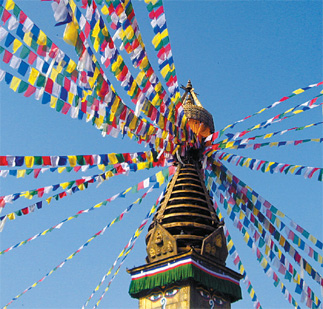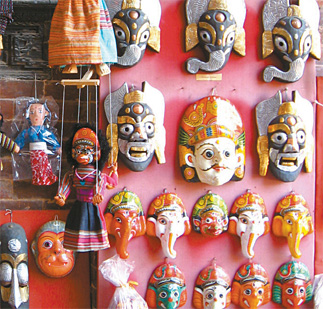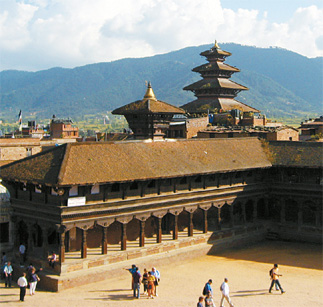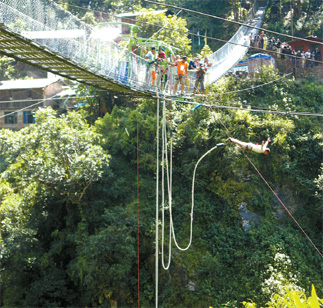Nepal’s natural beauty satisfies every appetite for outdoor adventure

Sunlight touches Dhaulagiri (8,167 meters) at sunrise seen from Poon Hill observatory. By Jung Ha-won
He turned around with a puzzled look and said, “You mean, this hill?”
And he resumed walking towards the peak of the “hill,” which he told me was 3,210 meters high.
Welcome to Nepal, the land of the high Himalayas and home of eight of the world’s 10 tallest mountains, where a peak 3,000 meters above the ocean is considered only a hill. Bordering China to the north and India to the south, the landlocked country has long been a dream destination for high-altitude adventure with more than 70 percent of its territory covered by mountains.

Kathesimbhu Stupa, a Hindi stupa located in northern Kathmandu.
Those flying into Nepal will land at Kathmandu, the nation’s biggest city and capital. It teems with the crazy hustle and bustle of any developing global boomtown. Old streets full of ancient architecture and temples are seamlessly integrated with the increasingly urban landscape. Street vendors selling baskets of vegetables and fruit, Snickers bars and cell phones stand side by side with stupas that are hundreds of years old and Hindu statues. Even Durbar Square, the heart of the old city and full of magnificent temples, is packed with street vendors, passersby and a ruthless flow of cars, motorbikes, bicycles and rickshaws. Even buffalo and other animal herds are ready to run over your feet if you don’t move quickly enough. So forget about serene meditation or a peaceful walk, and watch your feet when you stop for a quick photo.

Hand-carved wooden puppets and masks at stores in Bhaktapur, a serene, peaceful city east of Kathmandu.
If you are tired of the crazy Kathmandu clamor, a one-hour flight to the western part of the country takes you to serene Pokhara, the second-most-visited city in Nepal and the starting point for trekkers heading toward the Annapurna Range. Here you can start a three-week Annapurna Circuit route that climbs to as high as 5,416 meters, or a quick three- or four-day trek to Poon Hill observatory (3,210 meters), where you will be surrounded by a panoramic view of two of the world’s largest mountains - Annapurna (8,091 meters) and Dhaulagiri (8,167 meters) and enjoy a magnificent sunrise.
Don’t be afraid if you have little trekking experience. Quick trips to Poon Hill are often dubbed “baby treks” by locals, meaning they can be completed by novices like me and are nearly free of high-altitude sickness. Sure, you will need some stamina and physical fitness to trudge all the way past 3,000 meters, but those who are afraid of carrying heavy backpacks can hire a porter for around $10 a day.

An ancient city landscape in Bhaktapur. The entire town is designated as a Unesco World Heritage Site.
Some of the lodges have breathtaking views, so prop your feet up and look out a window at majestic valleys or enjoy a meal while gazing at the towering Annapurna and other peaks. By all means, it defines the phrase, “an experience you will never forget.”
If you return to Pokhara after days, weeks or months of trekking but miss the mountains already like many do, try paragliding along the peaks for an hour or more. October, November and December are considered the best times to hurl yourself off the slope and fly along the valleys. Up in the air, you can look down at the serene Phewa Tal lake, Pokhara’s most important landmark. The mirror-like water reflects the surrounding forest and high white peaks. Prices generally hover around $100 for trips lasting 40 to 90 minutes.

A bungee jumper dives into a gorge 160 meters deep at Nepal’s Tibetan border.
Still hungry for more adventure? Then try the world’s second-highest bungee jumping site. Standing in the middle of a narrow suspension bridge and looking down the river gorge 160 meters below me, I worried about what I had eaten for breakfast. Four hour’s drive from Kathmandu to northern Nepal bordering Tibet, the “Last Resort” offers this bungee jumping experience in a valley full of squeals and screams of free-falling divers. My two cents? Leave your brain at the end of the bridge as the jumping instructors wisely recommend. Many people don’t and end up taking a small baby step off the platform, which reduces the fun of free diving. Spread your arms, try to jump as far as possible from the platform and fly like an eagle. The package of a one-day trip to the Last Resort, including transportation and a lunch, wisely provided after the jump, costs 62 euros ($80).
OVERVIEW
The best time to visit Nepal is from October to November. The monsoon season ends in September leaving the sky clearer than at any other time of the year. Most trekking routes are also free of leeches and heavy snowfall. December to January is also a generally good time to travel, although the weather will turn from balmy to harsh cold at high altitudes. Heavy snow may block some major trekking routes as well. The tail end of the dry season from February to April is also a good time to visit with flowers blooming everywhere, although the dust that has settled over the past several months may disrupt visibility of the majestic mountain views. Foreign visitors can get a visa after arrival at the immigration counter at the Tribhuvan International Airport in Kathmandu, with a visa fee of $25 for a stay of up to 15 days and $40 days for up to 30 days. Flight prices vary from roughly 900,000 won ($609) to 1.3 million won depending on the season and fuel price swings.
By Jung Ha-won Staff Reporter [hawon@joongang.co.kr]










with the Korea JoongAng Daily
To write comments, please log in to one of the accounts.
Standards Board Policy (0/250자)